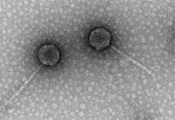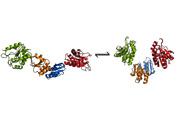Bacteriophages could be new tool to fight C. diff infections in hospitals
4 August 2014
A class of viruses called bacteriophages can infect and destroy the bacterium Clostridium difficile (C. diff), according to research at the European Molecular Biology Laboratory (EMBL) in Hamburg, Germany, and published in PLOS Pathogens.
C. diff is becoming a serious problem in hospital patients due to its resistance to antibiotics and the new findings could help bring about a new way of fighting this and other bacteria.
Bacteriophages are viruses that infect only bacteria and hijack the bacterium’s DNA-reading machinery to create new bacteriophages. These then start demolishing the bacterium’s cell wall. Once its wall begins to break down, the bacterial cell can no longer withstand its own internal pressure and explodes. The newly formed viruses burst out to find new hosts and the bacterium is destroyed in the process.

Electron microscopy image of the bacteriophages.
Credit: Kathryn Cross/IFR.
To harness the power of bacteriophages and develop effective therapies against bacteria like C.diff, scientists need to know exactly how these viruses destroy bacterial cell walls. The bacteriophage uses enzymes called endolysins to destroy the cell walls, but just how these enzymes are activated was unclear until now.

The analysed endolysins are activated by
switching
from a tensed, stretched state (left) to a relaxed
state (right).
Credit: EMBL/Rob Meijers.
“These enzymes appear to switch from a tense, elongated shape, where a pair of endolysins are joined together, to a relaxed state where the two endolysins lie side-by-side,” explains Matthew Dunne who carried out the work. “The switch from one conformation to the other releases the active enzyme, which then begins to degrade the cell wall.”
Meijers and collaborators discovered the switch from ‘standby’ to ‘demolition’ mode by determining endolysins’ 3-dimensional structure, using X-ray crystallography and small angle X-ray scattering (SAXS) at the Deutsches Elektronen-Synchrotron (DESY). They compared the structures of endolysins from two different bacteriophages, which target different kinds of Clostridium bacteria: one infects C. diff, the other destroys a Clostridium species that causes defects in fermenting cheese.
Remarkably, the scientists found that the two endolysins share this common activation mechanism, despite being taken from different species of Clostridium. This, the team concludes, is an indicator that the switch between tense and relaxed enzymes is likely a widespread tactic, and could therefore be used to turn other viruses into allies in the fight against other antibiotic-resistant bacteria.
The work was performed in collaboration with Arjan Narbad’s lab at the Institute of Food Research in Norwich, UK, who tested how engineering mutations in the endolysins affected their ability to tear down the bacterial cell wall.
Reference
Dunne, M et al. The CD27L and CTP1L endolysins targeting Clostridia contain a built-in trigger and release factor. PLoS Pathogens, 24 July 2014.